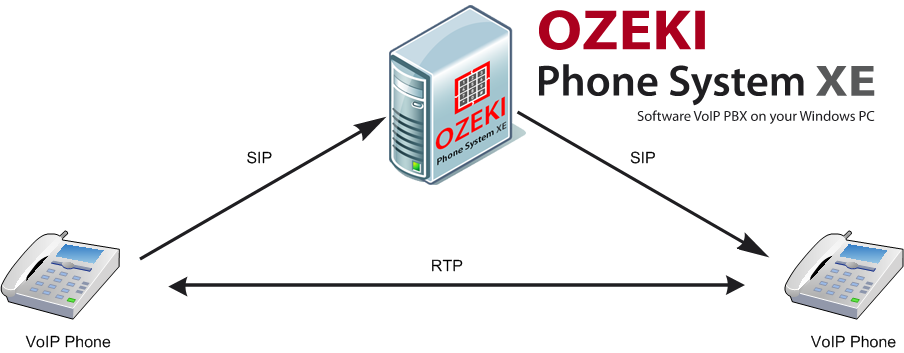What is SIP (Session Initiation Protocol)?
In this article you will be informed about the term and usage of Session Initiation Protocol. You can get informed about some basic definitions in this section. After this, you can get to know how SIP is used in practice. Following the general description, you can read about SIP phones and SIP phone systems as well. In the end, you can find a few words written especially for developers.
The Session Initiation Protocol (SIP) is the protocol that creates communication sessions among devices. The SIP is the signaling protocol of VoIP (Voice over Internet Protocol). The SIP protocol has role in building up and organizing the call line.
As Figure 1 explains, the Session Initiation Protocol builds up the communication channel between the two participants. The participants are the SIP Client and SIP Server:

The SIP cooperates with RTP (Real-time Transport Protocol). SIP is liable for the building up of the call, RTP is liable for the audio data transmission. SIP communicates via the phone centre (the PABX or Private Automated Branch eXchange). With RTP the parties can communicate directly (that is called peer-to-peer connection).
Protocol, Internet Protocol - Basic Definitions
A protocol is a standard set of rules that regulates data transmission among computers.
When computers are connected, they compress the data into
data packets and then send it to each other. These packets are similar to postal
packs: they must be addressed according to the regulations of the postal system
in order to get to the addressee.
The different protocols can be imagined as the postal systems of different countries: different
countries need different information to be able to deliver the packages. The SIP
protocol sends and receives the call control notifications as data packets. SIP
is built on the IP protocol.
The Internet Protocol (IP) is the protocol that is used for transmitting data packets via the Internet. Each computer connected to the Internet must have a unique IP address to be able to send and receive the data packets. The UDP (User Datagram Protocol) and TCP (Transmission Control Protocol) data transfer uses the IP protocol. The SIP can communicate via both the TCP and UDP protocol.
The SIP Protocol
Both in the traditional and Internet-based phoning technology, there are two
phases of the dial.
- First, the call line must be set up, and the participants must get connected.
This is the "job" of the SIP protocol.
- Once the call line is set up, the "data transfer" phase plays part: now the
information packages are moved by RTP protocol.
In the end, SIP disconnects the dial.
SIP was designed to set up real-time multimedia sessions between the communication endpoints. With SIP, users can make voice and video calls, instant messaging conferences, audio and/or video conferences as well.
In the example below, you can see that the SIP creates the communication channel between a VoIP Phone (e.g. the caller) and the SIP server (the Ozeki Phone System's PBX). On the other side another VoIP Phone (e.g. the called participant) and the SIP server are also connected with SIP. Now the two VoIP phones are connected, so the SIP protocol has nothing else to do: so the RTP protocol will transmit the data (Figure 2).

Getting to know SIP is a must if you are interested in Internet-based communication. It is also necessary if you are searching for a solution to modernise your old system.
SIP Phones and Systems
SIP protocol is most often used by businesses for building up communication systems based on the Internet. The endpoint can be a computer or any telecommunication device. The computer has to be equipped with a headset or a speaker and microphone to be able to make voice and video calls. The device must support VoIP (if the device supports VoIP, it also supports SIP).
There can be devices connected to this system called SIP phones, VoIP phones or simply softphones. After building up the network of proper connections, any softphone can be called even from a website. The Ozeki Phone System uses SIP to manage the calls.
With Ozeki Phone System, you can have an advanced, easy-to-use communication system that works with the softphones mentioned above. With using Ozeki Phone System, you can have webphones integrated into your business' homepage. You can have desktop or mobile devices connected to your server that manages internal and external calls as well. With this PBX you can connect to any telephone service provider's network in the world.
The Ozeki Phone System provides one of the best SIP implementations in the world. It is very resource efficient, it works with almost every SIP equipment you can find. It implements advanced features in the SIP protocol, such as mobile text messaging (VoIP SMS) and SIP device monitoring.
For Developers
SIP is a text-based protocol modeled on the request/response model used in HTTP, so it is easy to construct the messages and easy to see/decode. This protocol is definitely simpler than H.323 as well. Nevertheless, it is also able to model the behavior of even an advanced traditional telephone PBX.
Next Step
In order to get more information about this topic and some others related, take a look at our articles:
- What Is SIP Trunking?
- What Is SIP Trunk?
- What Is SIP Client?
- What Is SIP Server?
- What Is SIP Phone?
- What Is SIP Account?
If you became interested in this topic, please watch our video:
What is SIP? (Video tutorial)
